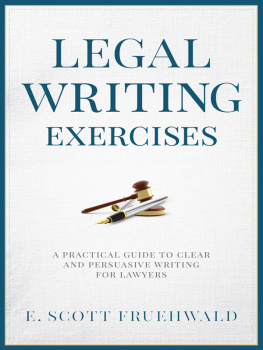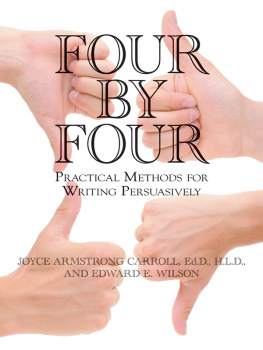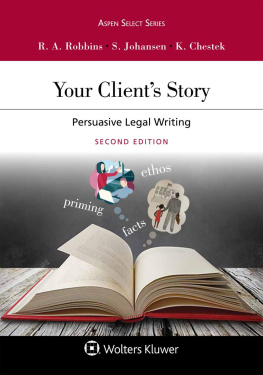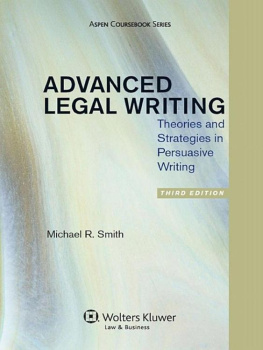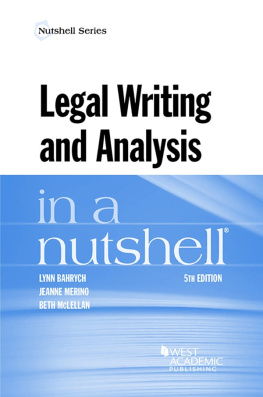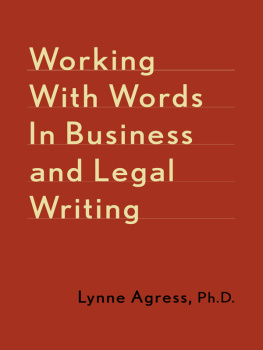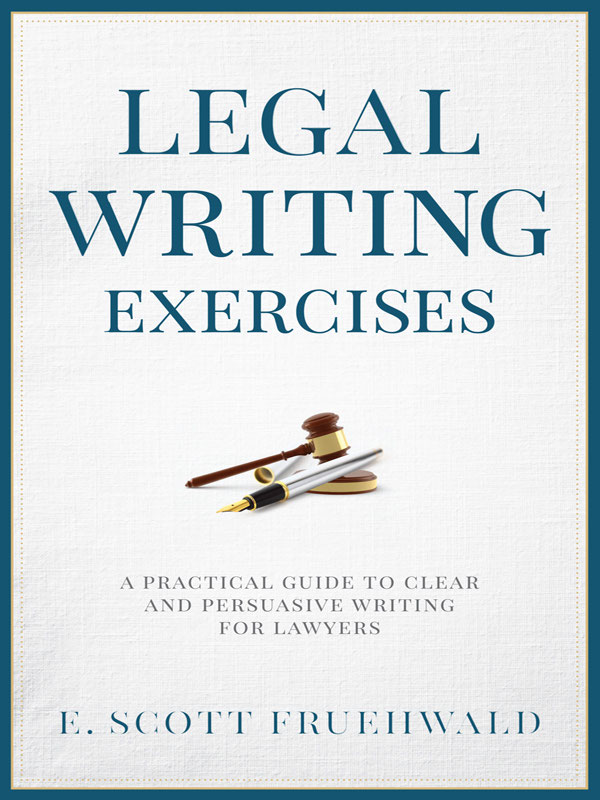E. SCOTT FRUEHWALD
I dedicate this book to my brother, Robert Douglas Fruehwald, who has shared the ride with me.
Contents
Preface
Communication is the key to success. No matter how brilliant a lawyers ideas may be, those ideas will remain unheard if the lawyer cannot communicate them effectively. Consequently, legal writing is a fundamental skill for lawyers and law students.
I have written this book to help lawyers and law students improve their writing. This book is self-contained (the answers to the exercises are located immediately following the exercises). Lawyers in any stage of their career can use it to help improve their writing skills, or they can use it to become aware of what they should correct in the writing of their employees. Law students can employ this tome to improve their writing immediately before law school or while they are taking legal writing. Legal writing professors can adopt it as a supplement in legal writing class. Writing and academic support specialists can use it to help struggling law students. Finally, while I have written this book specifically for lawyers, most of it can be used by anyone who wants to write better.
How is this book different from other books on legal writing? It mainly teaches you editing and writing through exercises. Many books on legal writing have few editing exercises. However, educational researchers believe that the most effective way to learn is through active learningthrough doing. Active learning also helps turn items in short-term memory into long-term memory. In addition, educational experts think that repetition helps one retain knowledge in long-term memory; a pattern needs to be retrieved again and again to become a permanent memory or skill. Similarly, the key to becoming a good writer and editor is awareness. Fixing writing problems once you find them is usually easy. The hard part is finding the mistakes in your writing. The exercises in this book will help you develop the ability to find problems in your writing and the writing of others. I believe that the numerous exercises in this book will help you improve your writing much more than books that contain no exercises or only a few exercises.
This book is also different because it covers subjects that other legal writing books dont cover, such as creating emphasis, continuity and flow within paragraphs, continuity and flow between paragraphs, small-scale organization, and taking a holistic approach to writing. Producing clear and effective writing involves much more than being able to change passive voice to active voice and eliminating wordiness. It concerns being able to combine the mechanics of writing with a conceptual (holistic) view of writing.
It is very important that you do the exercises slowly and carefully. One cannot learn superficially. You should make sure that you understand each concept, and, when you make a mistake, why you have made that mistake. In addition, you should make sure that you understand all the answers.
This book begins with an introduction that presents the general principles of clear and effective writing. The remaining chapters deal with the details of editing, progressing from editing sentences to large-scale organization. Chapter 2 concerns active and passive sentences and writing with verbs. Chapter 3 involves editing for wordiness. Chapter 4 teaches emphasis, clarity, and specificity, while Chapter 5 shows how to combine sentences and edit paragraphs. Chapter 6 covers organizing paragraphs and creating coherence. Chapter 7 shows you how to write a small-scale paradigm, and Chapter 8 discusses large- and medium-scale organization. The book concludes with review exercises and a glossary. Although I have written this book to be read consecutively, you can skip to a chapter that teaches an editing skill that you are having particular problems with.
I start each of my legal writing classes by telling my students that my goal for the class is to make myself unnecessary. I want them to take what I have taught them and use that to become their own critic of their writingto become their own legal writing teacher. I hope I can do the same for you with this book.
Chapter 1
Introduction: General Principles of Writing and Editing
Chapter Goals
To introduce you to the general principles of writing.
To help you understand the three stages of writing.
To help you understand the pre-writing stage.
To help you focus on the purpose of your writing.
To help you focus on your audience.
To help you consider the restraints on an assignment.
To help you see the importance of planning.
To help you think about strategy in persuasive writing.
To help you understand the importance of the editing stage.
To introduce you to general principles of editing.
To help you develop the habit of reading your writing out loud.
To help you develop the habit of reading your writing from anothers viewpoint.
To help you develop a holistic approach to writing.
To help you develop the habit of reading your writing carefully.
To help you become your own critic.
To help you develop the habit of challenging your writing.
To help you reflect on your writing.
The best way to become a self-directed learner is to develop attitudes and habits. The first attitude I want you to develop is I will become a reader-oriented writer. Most authors write for themselves, and they do not give much thought to their readers. As a result, the reader often misunderstands what the author has said. In contrast, successful writers focus on their readers. They know that it is the writers responsibility to fully communicate his ideas to his reader. A reader shouldnt have to read a passage twice. The second attitude I want you to possess is I will try to communicate to my reader as fully as possible.
The exercises in this book are intended to help you develop habits so that you will become a reader-oriented writer who fully communicates her ideas to the reader. However, before starting the exercises you need to learn some general principles about writing.
The Three Stages of Writing
Writing consists of three stages: (1) the pre-writing stage, (2) the writing stage, and (3) the editing stage (the post-writing stage). You should spend an equal amount of time on each of these three stages. I will only discuss the pre-writing stage and the editing stage in this section.
The Pre-writing Stage
In the pre-writing stage, you should define the writings parameters. What is your purpose in writing? Who is your audience? Are there any restraints on the composition? What is your plan?
A papers general purpose is often obvious. For example, your boss may ask you to write a memorandum on the law of constructive eviction in Virginia. However, can you go into more detail? Has your boss asked you to write the memorandum so that he can learn the general law on constructive eviction, or does the assignment concern a particular case? Should you look just at Virginia law or also at the law of other jurisdictions? If a case is involved, what is the procedural posture? Having a clear picture of the writings purpose not only saves time, but helps you focus and organize your writing.

